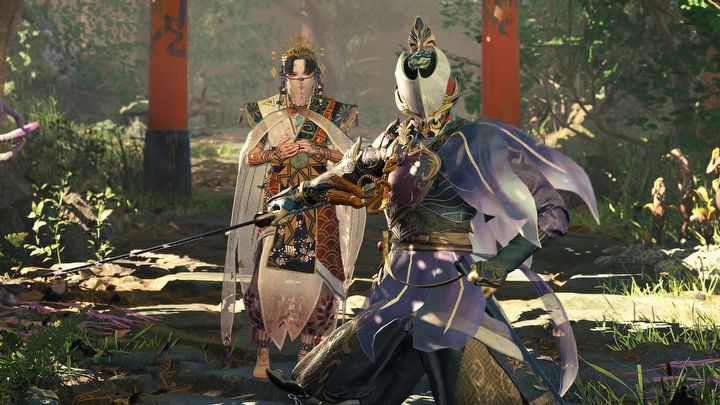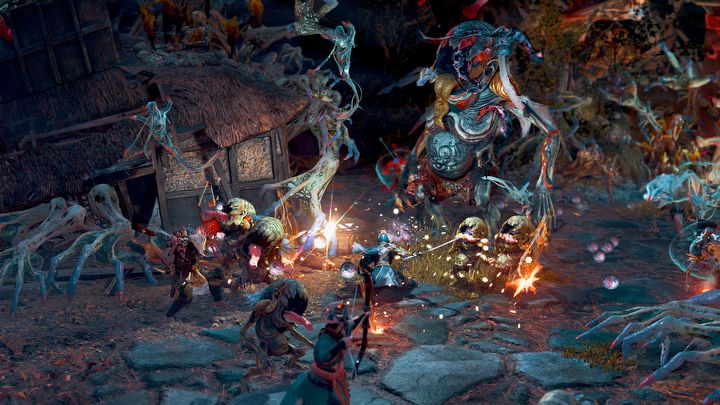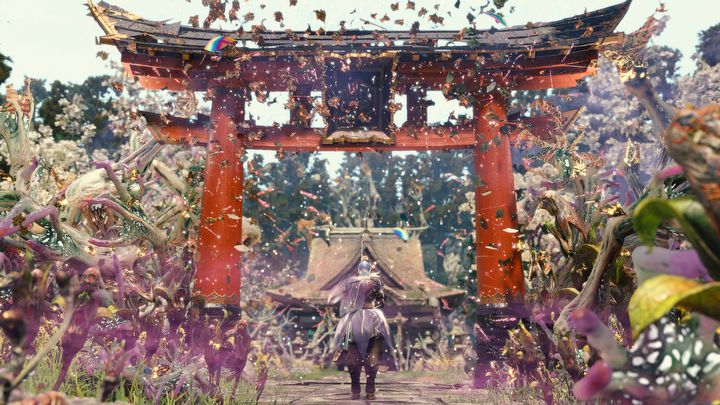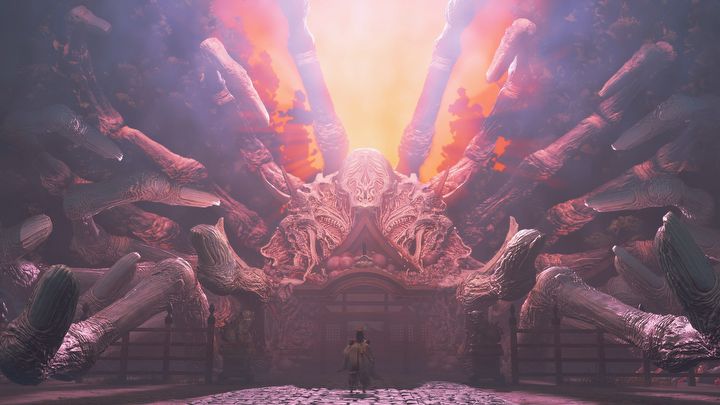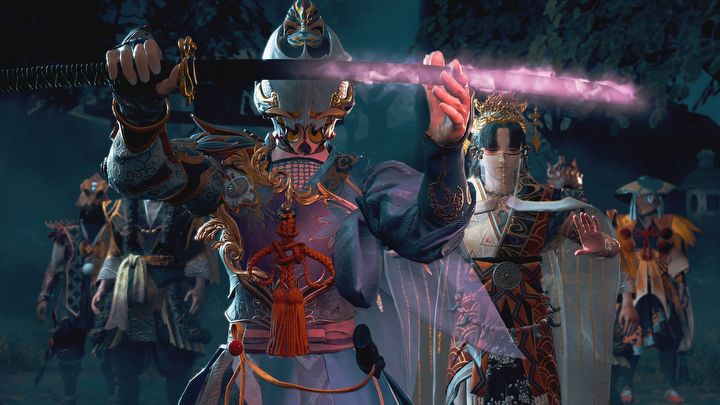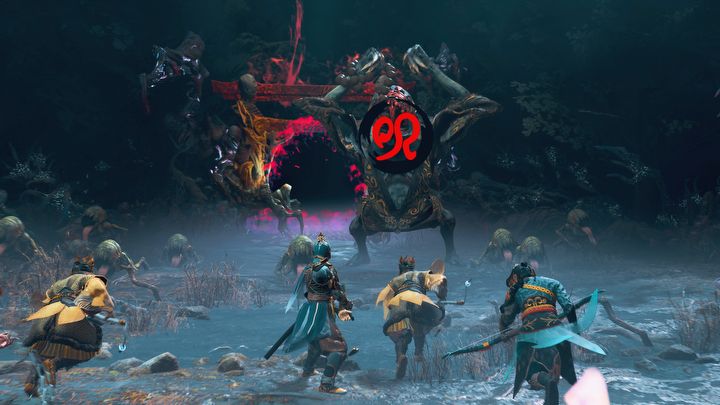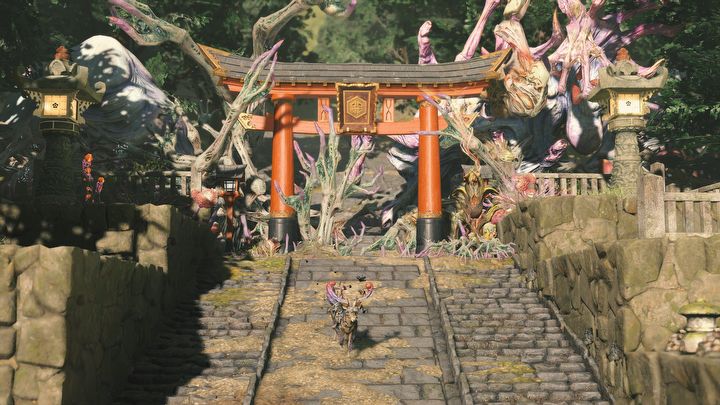Kunitsu-Gami: Path of the Goddess Review: A Beautiful Blend of Action and Strategy
Fight waves of horrific monsters and cleanse the mountain of defilement in Kunitsu-Gami: Path of the Goddess, a unique blend of action and strategy with a gorgeous Japanese backdrop.
The review is based on the PS5 version. It's also relevant to PC, PS4, XONE, XSX version(s).
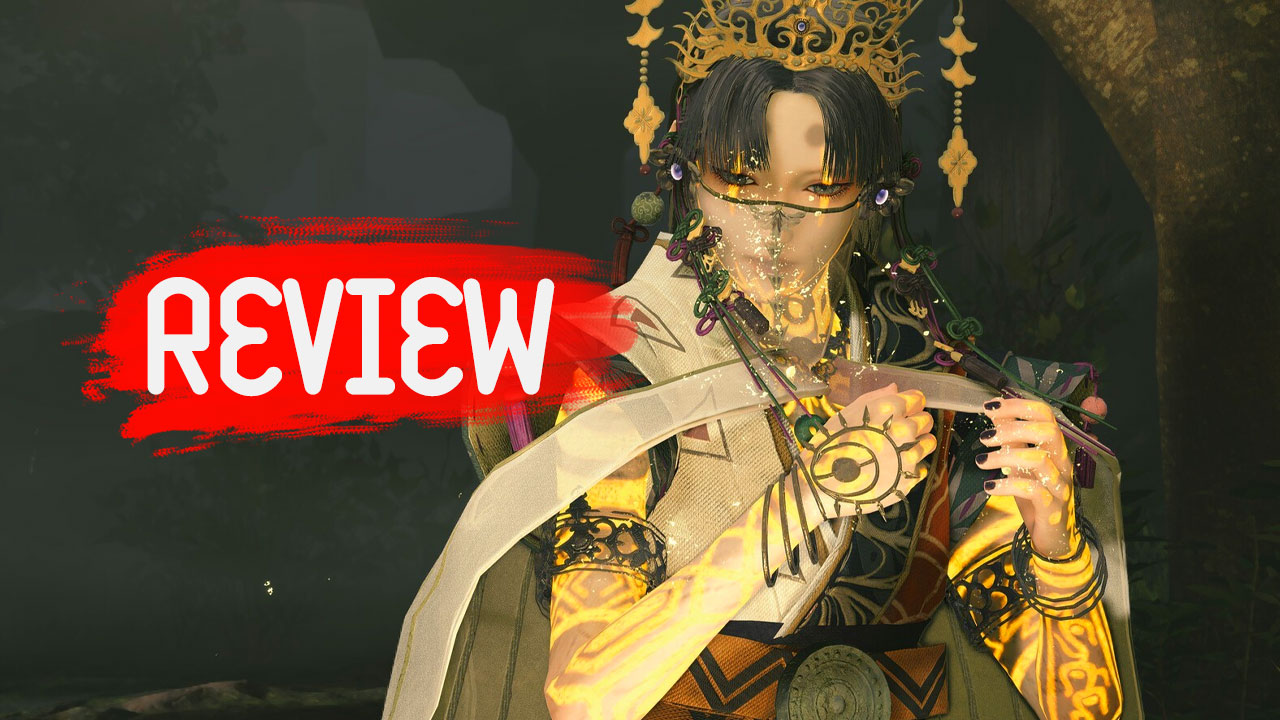
Capcom’s Kunitsu-Gami: Path of the Goddess shouldn’t work as well as it does. Over the years I have tried to engage with many kinds of real-time-strategy games, but none have captured my attention quite like this one. Everything taking place in a beautifully realized Japanese mountain setting definitely doesn’t hurt. In Kunitisu-Gami, you play as the dancing warrior Soh, who is guiding Yoshiro, a woman with incredible purification powers, through defiled villages to purify corrupted Torii gates and defeat the dangerous monsters that travel through them. Rescue villagers during the day and command them to help you fight off waves of enemies at night, leading the charge yourself. Part tower defense, part real-time strategy, and part third-person hack-and-slash action, Kunitsu-Gami: Path of the Goddess somehow balances all of those genres while still being a fun game.
Mt. Kufuku was once the lush and vibrant home of the Goddess, but now it lies in defiled ruin. The twelve masks, powerful artifacts containing the Goddess’ power, are stolen by cursed monsters known as “seethe.” The villages and the villagers within them are overtaken by corruption, leaving them trapped in cocoon-like pods throughout the area. Soh can free them and use the masks to assign them special powers and abilities in the fight against the seethe.
To save a village, Soh must carve a path for Yoshiro through to the defiled Torii gate so that she can cleanse it. Each night seethe pour from the corrupted gate and into the real world to attack her, making the job of reaching it more challenging the closer she gets. Kunitsu-Gami: Path of the Goddess surprised me this year at Summer Game Fest with how well its blending of different genres manages to work, and thanks to Capcom, I had the opportunity to get an early look at this unique game.
Kagura Action Strategy
Self-described as a “kagura” action strategy game, the developers behind Kunitsu-Gami do not say this lightly. Translated to English, kagura means “god entertainment,” and is a type of ritual used in Japan for purifying the spirit. This explains Soh’s dance-like swordplay and Yoshiro’s ritualistic performances that purifies the defilement. This game gladly draws on Japanese culture, using folklore, myths, and legends to inspire much of the game.
Purifying a village of defilement is important, but it’s also never the final step. Once purified, a village still needs plenty of reconstruction. Soh commands the villagers here as well, assigning them work to complete while Soh and Yoshiro continue saving other villages. It is best to return to each village often and make sure the villagers are hard at work, not only because it greatly improves the aesthetic of the village itself, but each completed construction rewards the player with collectibles and resources. This naturally creates a satisfying game loop. Set villagers to rebuild, go off and fight seethe, come back and earn rewards, and repeat, growing stronger with each repetition.
Kunitsu-Gami: Path of the Goddess is full of unique collectibles that add to and expand on the lore behind the enemies and the villagers. Defeating a boss unlocks an item that explains the story behind the monster. Players can read the lore of the common enemies by reconstructing the defiled villages. This reconstruction can provide practical resources such as the musubi for villager upgrades, but it can also unlock another collectible: graphically impressive food. I don’t know why this is included other than the fact that it looks great. From what I can tell these food items don’t seem to add any mechanical benefit to the gameplay, but each treat is explained in detail including its ingredients and cultural significance.
Villager Tactics
Saving a village will generally grant access to a boss battle. These can vary in the level of challenge, but defeating these bosses unlocks new archetypes for villagers, which is easily the highlight of Kunitsu-Gami for me. The first few roles are simple like the axe-wielding woodcutter and the long-range archer, but after defeating further boss battles, the player begins to unlock more complex units like the healing sage and the sumo wrestler. Each of these units can be upgraded to deal more damage, have more health, and use special attacks and abilities.
Villager placement on the battlefield is key to surviving the night. Archers can pick of weak enemies at a distance, and woodcutters will only fight within a short radius around themselves. Each unit needs the support of the others to be the most effective. An archer can pick of a few airborne enemies but can get quickly overwhelmed if a group of ground-based seethe get too close. The woodcutter has no attacks to hit airborne targets but can defend the archer from melee enemies. The tactical placement of every unit will make a huge difference.
- well executed combination of action and strategy;
- challenging but still accessible;
- meaningful connection to Japanese culture;
- tactical elements feel natural with a controller.
- not every gameplay element will click with everyone;
- some villager distinctions seem unecessary.
The gameplay begins simply enough. Place units in the right places and fight off swarms of seethe as they attempt to stop the purification. New levels introduce new twists. At first, this is just new enemy types or branching paths. But the later levels introduce completely new challenges such as fighting in a cave, which requires the player to command villagers to light lanterns so they can actually see the enemy. Or fighting on moving boats, which involves giant enemy seethe trying to sink the boats with villagers on them.
Real-Time Strategy With a Controller?
For this review, I primarily played Kunitsu-Gami on the PlayStation 5 with a DualSense controller. While the action elements were no problem, I do not typically think of a controller as well suited for a strategy game. However, it felt very natural. The only thing that was marginally easier on PC was commanding villagers to move to certain locations, but ultimately this wasn’t enough of an issue that I preferred a mouse and keyboard.
Soh’s actions include several simple attacks that can be comboed with dance attacks. These moves are flashy, deal more damage, and are excellent for dealing with specific targets or crowds of seethe. Soh can also block enemy attacks, though not all attacks are blockable, so they also have a dodge option. The player’s customization mostly comes from a handful of optional abilities. The first one unlocked unleashes two fiery slashes that don’t do a lot of damage but can hit many targets. My particular favorites have been an ability that lets Soh temporarily boost the villager’s defense and another that creates a temporary dome shield that will deflect enemy attacks.
Much like how Kunitsu-Gami balances action and strategy, Soh must balance fighting the seethe directly, and commanding the villagers to defend Yoshiro. Surprisingly, these elements do not get in each other’s way at all. Choosing a role for a villager or opening the command screen pauses the battle, giving the player the opportunity to consider their options. I was able to complete most levels on the first try, so I would not say that Kunitsu-Gami will be the most challenging strategy game for everyone, but it is easy to make things harder for yourself. Using up resources early on and placing villagers in dangerous positions is a quick way to be overrun. Remember that the primary goal is to protect Yoshiro, so prioritizing anything else is a quick route to defeat.
A tower defense strategy game shouldn’t work as well as this does, even if it’s upgraded with gorgeous graphics and hack-and-slash action. Capcom’s Kunitsu-Gami: Path of the Goddess is one of the most surprising and unique games of the year so far for good reasons. Every part of this game, from unlocking and upgrading villager roles, to strategically placing them on the battlefield, and then jumping straight into the fight yourself is engaging and exciting. Even if you aren’t a fan of strategy or action games, this is enough of a blend that it still comes highly recommended.
Find all our reviews on Metacritic and Opencritic.
Conclusion
There is so much more to talk about with Kunitsu-Gami: Path of the Goddess. But I only have so much time and I do want to make sure there is enough of the game left for you to experience on your own. But there are a few more things I want to mention: sumo wrestler is probably my favorite villager archetype, but ever since unlocking the healing sage, I cannot go into a fight without one. One strange thing about both of those units is that they cannot be applied to any villager, as many of the other roles like archer and woodcutter can. Through the game mechanics, only villagers who have a certain symbol can be given those specific roles, though it does seem that only male villagers can be sumo wrestlers while only female villagers can become sages. This feels somewhat out of place especially since these kinds of distinctions don’t come up anywhere else in the game.
Both Soh and villagers can re-spec their upgrade points at any time, which is a great way to encourage experimentation and tactical planning. For example, if I know that the sage will be important to an upcoming battle, I can steal upgrade points from another role and max out the sage instead, then change it back afterwards. This is a great way to let players explore the abilities at their disposal with little consequence for choosing what they don’t know.
Overall, Kunitsu-Gami: Path of the Goddess stands out as a game that masterfully combines elements from across the video game spectrum. This game manages to be challenging, without being inaccessible. Kunitsu-Gami launches on July 18th, 2024 for Xbox One, Xbox Series X/S, and Xbox Game Pass, as well as PlayStation 4, PlayStation 5, and PC via Steam.
Kunitsu-Gami: Path of the Goddess
Kunitsu-Gami: Path of the Goddess Review: A Beautiful Blend of Action and Strategy
Fight waves of horrific monsters and cleanse the mountain of defilement in Kunitsu-Gami: Path of the Goddess, a unique blend of action and strategy with a gorgeous Japanese backdrop.

